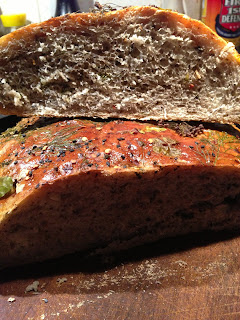 After reading Andew Whitley's book, Bread Matters, I decided to try out making yeast-leavaned bread for once in my life. I recommend his book to those interested in bread-making, as it covers a wide scope of bready topics and explains rather well dough-related jargon and practices.
After reading Andew Whitley's book, Bread Matters, I decided to try out making yeast-leavaned bread for once in my life. I recommend his book to those interested in bread-making, as it covers a wide scope of bready topics and explains rather well dough-related jargon and practices.Here, I'm posting his recipe for a simple white bread, with my modifications.
As an aside, throughout the book, Whitley reminds the readers that a wet, difficult to work with dough is not terrible. This dough will stick to your hands quite a bit, but Whitley is correct that adding extra flour really does do unsavory things to the texture. For this reason, I kneaded the dough in the air, and as it could not stick to a table, the temptation to add excess flour was minimal.
 Ingredients
Ingredients♕600g / 4.75 cups strong bread flour
♕(200g + 200g) / (1 cup+ 0.6 cup) warm (~35˚C / 95˚F) water
♕8g / 0.25 oz fresh yeast
♕3g / 2T dried black tea leaves, powdered
♕5g / 1t salt
♕3g / 1T chili pepper flakes
♕30mL / 2T sesame seed oil
♕5g / 3T fresh chives, chopped finely
♕2g / 1.5t fresh ginger, grated
♕Handful arugula leaves, torn into shreds
♕5-10 basil leaves, torn into shreds
♕3 cloves garlic, diced
♕3g / 1T black sesame seeds
♕Butter or coconut oil, for oiling
♕1 egg yolk
♕Well-preserved herb leaves, herby flowers, sesame seeds, and chili pepper flakes to decorate
Procedure
♕In a bowl, mix bread flour, tea leaves, chili pepper flakes, and salt
♕Dissolve 8g yeast in 200g warm water, and pour water into flour mixture.
♕Wash out bowl with remaining 200g water, and pour into flour mixture.
♕Using your hands, mix the dough until it comes together.
♕Lift dough out of the bowl and knead in the air, as though you were clapping, for 10-15 minutes. The dough should be relatively smooth at the surface, springy, and supple.
♕Return dough to its bowl and cover with a plastic bag.
♕Let rest in a warm place for 2 hours, or until dough has doubled in volume.
♕After 2 hours, oil a large cooking vessel.
note: cast iron cookware gives a great-looking crust to the bread.
♕Assemble ginger, sesame seeds, arugula, basil, garlic, and sesame oil. Place on top of dough.
♕Take dough out of bowl and incorporate additions into dough using kneading motions.
♕On a flat, lightly floured surface, plop down dough and flatten into a square.
♕Fold in half, and flatten.
♕Roll into thirds, and flatten again.
♕Roll into a cylinder and transport into cooking vessel
note: these steps are done to arrange the dough's gluten proteins in such a way that the dough doesn't try to explode from the bread as it bakes. They are much easier said than done, and I did these steps very loosely.
♕Let rise in cooking vessel for 30 or so minutes.
♕Preheat oven to 230˚C/450˚F
♕Break an egg yolk in a small bowl, and brush onto risen dough, gently, so as to not deflate it.
♕Decorate dough as you wish with flowers, leaves, herbs, and seeds.
note: I used dill, onion flowers, arugula flowers, wood sorrel, basil, and arugula leaves. These additions do not affect the flavor of the bread's dough.
♕Bake for 10 minutes, rotating halfway if you have poor convection.
♕Turn oven down to 205˚C/400˚F.
♕Bake for another 30 minutes, again turning halfway if you have poor convection.
♕If dough sounds dense after baking time has passed, let sit in hot oven for 5 or so minutes.
♕Remove from oven, cover in a cotton cloth, and let cool on a wire rack to prevent soggy bread bottoms.




